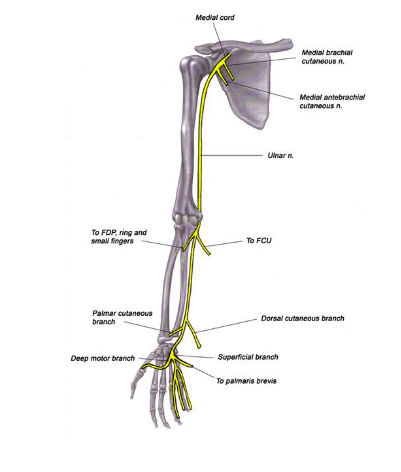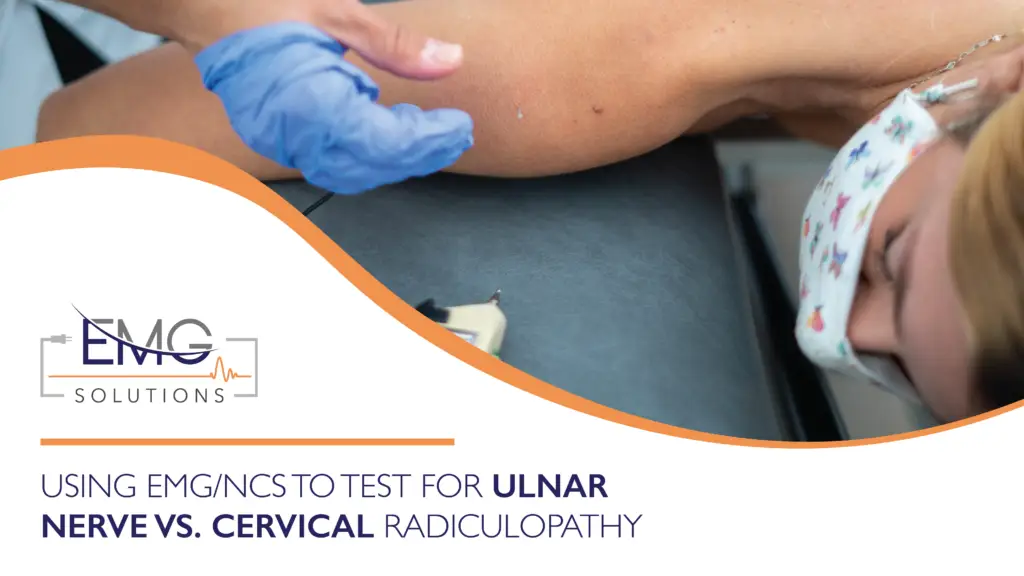When starting the initial evaluation, you mention to the clinician performing the nerve
test that you are experiencing numbness of the ring and pinky finger. The clinician will
ask additional questions as they formulate a list of differential diagnoses or the most
likely causes for your issue. This will help them determine the things they need to give
special attention to during the testing. For this specific example involving numbness of
the ring and pinky fingers, there are three causes most likely that can be found below.
The differential diagnosis may be something like:
- An ulnar nerve issue at the elbow (cubital tunnel)
- A cervical (neck) nerve root level issue at C8-T1
- An ulnar nerve issue at the wrist (Guyon’s Canal)
The ulnar nerve is a nerve that starts off from a bundle just behind the collar bone called
the brachial plexus. From here it dives down the underside of the arm, around the elbow
(through the cubital tunnel), down the inside (if your palms are facing forward) portion
of the forearm, through a gap in the wrist known as Guyon’s canal and ends as it goes
into the hand.

Specifically in the hand, there are sensory fibers that will supply the nerve with the
ability to sense touch in the ring and pinky finger. Additionally, there are motor
fibers that go to the muscles between your fingers that help with spreading your
fingers out and in some people can help with the muscle movement of the large
muscle at the base of your thumb (on the palm side).
How does a nerve test find the issue?
There are two tests that clinicians use to assess the nerves. When performing these
tests, the clinician might explain it to the patient by saying, “Your nerves are
similar to wires in the wall and the first part of testing is like testing the insulation
around the wires. This insulation helps with how quick the nerve will respond,
how fast it is between points, and impacts some of the flow or amount of
electricity that runs through the nerve”. This first part of the test is called a nerve
conduction study or NCS which requires a small electrical stimulator that will be
placed on the skin over the nerve to assess these components. The main areas
of focus are on the quickness (defined as latency) of the nerve’s response, speed
between points on the arm (nerve conduction velocity), and amount of electricity
(amplitude) of the response. If the issue is at the wrist, the NCS would show the
nerve as being slow to respond at the wrist (for Guyon’s canal). If the issue is at
the elbow, then there would be a slow speed across the elbow (for cubital tunnel
syndrome). If a nerve issue is present for a long period of time or if the nerve’s
compression is severe enough, it will affect the amount of electricity able to flow
through the nerve, affecting the amplitude.
The second part of the test is called electromyography or EMG which is performed
with a very small thin needle. For an ulnar nerve issue, abnormal EMG findings
are not expected except in more severe cases. When this happens, you will only
see EMG issues in ulnar innervated muscles downstream (further down the arm)
from the location of the injury. Examples of muscles that would likely have EMG
findings can be found below.
Ulnar nerve issue at the cubital tunnel:
- Flexor carpi ulnaris
- Flexor digitorum profundus
- Abductor digiti minimi
- First dorsal interosseous of the hand
Ulnar nerve issue at Guyon’s Canal:
- First dorsal interosseous of the hand
- Abductor digiti minimi
Cervical spine issues for C8-T1:
- The interosseous muscles of the hand, not limited to the first dorsal.
- Abductor digiti minimi
- Abductor pollicis brevis
- Flexor digitorum profundus
- Flexor carpi ulnaris
Addison Davis, PT, DPT
EMG Solutions Resident



